gulden
1458, Hungary, Mathias Corvinus. Rare Gold Gulden (Ducat) Coin. Gem! PCGS MS-64
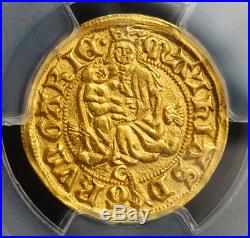
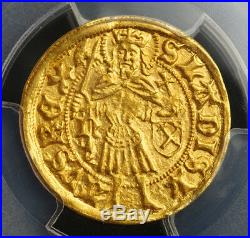
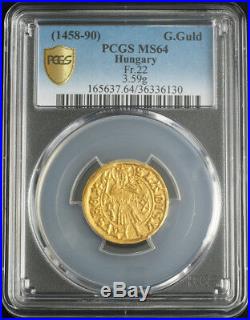
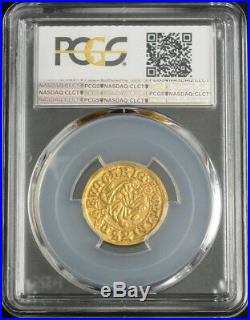

1458, Hungary, Mathias Corvinus. Rare Gold Gulden (Ducat) Coin. Certified and graded by PCGS as MS-64! Reference: Friedberg 22, Pohl K15-6, Huszar 680. Denomination: Gold Ducat / Gold Gulden. Mint Place: Nagybanya (n, today´s Baia Mare, Romania) Mint master (Kammergraf): Thomas Altemberger, Bürgermeister. Diameter: 21mm Weight: 3.49gm Material: Gold! Obverse: Saint Ladislaus I standing facing, holding ax and globus cruciger. Mint initial (n) and privy mark (shield with crossed hammers) of the mint official (Thmas Altemberger) in fields. REX Reverse: Crowned Holy Virgin enthroned facing, cradling Holy Infant; thistle head to either side. Legend: + MATTHIAS D (raven with ring in beak) G R VNGARIE. 1040 29 July 1095 was King of Hungary from 1077 until his death, “who greatly expanded the boundaries of the kingdom and consolidated it internally; no other Hungarian king was so generally beloved by the people”. Before his ascension to the throne, he was the main advisor of his brother, Géza I of Hungary, who was fighting against their cousin, King Solomon of Hungary. When his brother died, his followers proclaimed Ladislaus king according to the Hungarian tradition that gave precedence to the eldest member of the royal family to the deceased king’s sons. Following a long period of civil wars, he strengthened the royal power in his kingdom by introducing severe legislation. He also could expand his rule over Croatia. After his canonisation, Ladislaus became the model of the chivalrous king in Hungary. Matthias Corvinus , also called Matthias I Hungarian. 23 February 1443 6 April 1490, was King of Hungary and Croatia from 1458 to 1490. After conducting several military campaigns, he was elected King of Bohemia in 1469 and adopted the title Duke of Austria in 1487. He was the son of John Hunyadi, Regent of Hungary, who died in 1456. In 1457, Matthias was imprisoned along with his older brother, Ladislaus Hunyadi, on the orders of King Ladislaus V of Hungary. Ladislaus Hunyadi was executed, causing a rebellion that forced King Ladislaus to flee Hungary. After the King died unexpectedly, Matthias’s uncle Michael Szilágyi persuaded the Estates to unanimously proclaim Matthias king on 24 January 1458. He began his rule under his uncle’s guardianship, but he took effective control of government within two weeks. As king, Matthias waged wars against the Czech mercenaries who dominated Upper Hungary (today parts of Slovakia and Northern Hungary) and against Frederick III, Holy Roman Emperor, who claimed Hungary for himself. In this period, the Ottoman Empire conquered Serbia and Bosnia, terminating the zone of buffer states along the southern frontiers of the Kingdom of Hungary. Matthias signed a peace treaty with Frederick III in 1463, acknowledging the Emperor’s right to style himself King of Hungary. In this year, Matthias invaded the territories that had recently been occupied by the Ottomans and seized fortresses in Bosnia. He soon realized he could expect no substantial aid from the Christian powers and gave up his anti-Ottoman policy. These measures caused a rebellion in Transylvania in 1467, but he subdued the rebels. The next year, Matthias declared war on George of Podbrady, the Hussite King of Bohemia, and conquered Moravia, Silesia, and Lausitz, but he could not occupy Bohemia proper. The Catholic Estates proclaimed him King of Bohemia on 3 May 1469, but the Hussite lords refused to yield to him even after the death of their leader George of Podbrady in 1471. Instead, they elected Vladislaus Jagiellon, the eldest son of Casimir IV of Poland. A group of Hungarian prelates and lords offered the throne to Vladislaus’s younger brother Casimir, but Matthias overcame their rebellion. Having routed the united troops of Casimir IV and Vladislaus at Breslau in Silesia (now Wrocaw in Poland) in late 1474, Matthias turned against the Ottomans, who had devastated the eastern parts of Hungary. He sent reinforcements to Stephen the Great, Prince of Moldavia, enabling Stephen to repel a series of Ottoman invasions in the late 1470s. In 1476, Matthias besieged and seized abac, an important Ottoman border fort. He concluded a peace treaty with Vladislaus Jagiellon in 1478, confirming the division of the Lands of the Bohemian Crown between them. Matthias waged a war against Emperor Frederick and occupied Lower Austria between 1482 and 1487. Matthias established a professional army (the Black Army of Hungary), reformed the administration of justice, reduced the power of the barons, and promoted the careers of talented individuals chosen for their abilities rather than their social statuses. Matthias patronized art and science; his royal library, the. Was one of the largest collections of books in Europe. With his patronage, Hungary became the first country to embrace the Renaissance from Italy. As Matthias the Just, the monarch who wandered among his subjects in disguise, he remains a popular hero of Hungarian folk tales. The item “1458, Hungary, Mathias Corvinus. Rare Gold Gulden (Ducat) Coin. Gem! PCGS MS-64″ is in sale since Wednesday, December 19, 2018. This item is in the category “Coins & Paper Money\Coins\ World\Gold”. The seller is “coinworldtv” and is located in Europe. This item can be shipped worldwide.
- Certification: PCGS
- Certification Number: 36336130
- Year: 1458-1490
- Grade: MS64
- Composition: Gold

1423, Frankfurt, Sigismund of Luxembourg. Gold Gulden (Ducat) Coin. PCGS AU-53
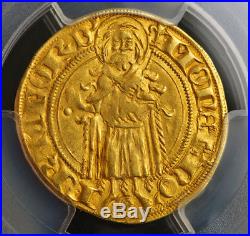
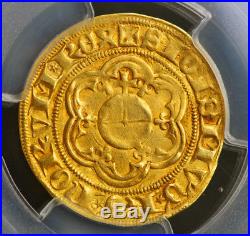
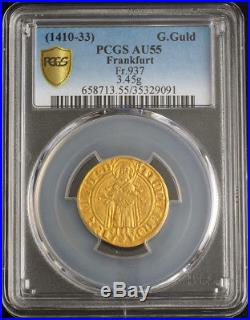
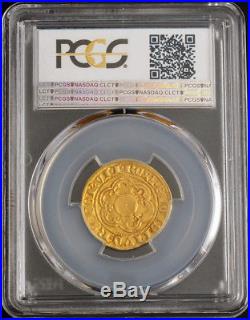

1423, Frankfurt, Sigismund of Luxembourg. Gold Gulden (Ducat) Coin. Certified and graded by PCGS as AU-53! Reference: Friedberg 937, Joseph/Fellner 103, KM. Mint Official: Vois II von Winterback (privy mark: crescent with face inside) Material: Pure Gold. 986 Diameter: 21mm Weight: 3.45gm. Obverse: Standing nimbate figure of Saint John, holding lis-topped scepter in left hand. Privy mark (crescent with face iniside) of the mint master below between his legs. Interesting privy mark (pellet) in left field! Legend: MONET’ NO’ (crescent with face iniside) FRA’ CFORD’ Reverse: Cross-topped imperial orb within polylobe with five lis symbols inwards. All within inner circle. Legend: + SIGISMV’ D’ RO’ NORVM’ REX. Frankfurt was one of the most important cities in the following Holy Roman Empire. From 855 the German kings and emperors were elected in Frankfurt and crowned in Aachen. From 1562 the kings/emperors were also crowned in Frankfurt, Maximilian II being the first. This tradition ended in 1792, when Franz II was elected. His coronation was deliberately held on Bastille Day, 14 July, the anniversary of the storming of the Bastille. The elections and coronations took place in St. Bartholomäus cathedral, known as the Kaiserdom (en: Emperor’s Cathedral), or in its predecessors. The Frankfurter Messe (Frankfurt Trade Fair) was first mentioned in 1150. In 1240, Emperor Friedrich II granted an Imperial privilege to its visitors, meaning they would be protected by the Empire. The fair became particularly important when similar fairs in French Beaucaire lost attraction around 1380. Book trade fairs have been held in Frankfurt since 1478. In 1372 Frankfurt became a Reichsstadt (en:Imperial city), i. Directly subordinate to the Holy Roman Emperor and not to a regional ruler or a local nobleman. Frankfurt managed to remain neutral during the Thirty Years’ War, but suffered from the bubonic plague that was brought to the city by refugees. After the end of the war, Frankfurt regained its wealth. Sigismund of Luxembourg (15 February 1368 9 December 1437) was Prince-elector of Brandenburg from 1378 until 1388 and from 1411 until 1415, King of Hungary and Croatia from 1387, King of Germany from 1411, King of Bohemia from 1419, King of Italy from 1431, and Holy Roman Emperor for four years from 1433 until 1437, the last male member of the House of Luxemburg. Sigismund von Luxembourg was the leader of the last West European Crusade – the Crusade of Nicopolis of 1396 to liberate Bulgaria and save Constantinople from the Turks. Afterwards he founded the Dragon Order to fight the Turks. He was regarded as highly educated, spoke several languages (among them; French, German, Hungarian, Italian, and Latin) and was an outgoing person who also took pleasure in the tournament. Sigismund was one of the driving forces behind the Council of Constance that ended the Papal Schism, but which in the end also led to the Hussite Wars that dominated the later period of Sigismund’s life. The item “1423, Frankfurt, Sigismund of Luxembourg. Gold Gulden (Ducat) Coin. PCGS AU-53″ is in sale since Monday, May 14, 2018. This item is in the category “Coins & Paper Money\Coins\ World\Gold”. The seller is “coinworldtv” and is located in Europe. This item can be shipped worldwide.
- Certification: PCGS
- Certification Number: 35329091
- Grade: AU53
- Composition: Gold
